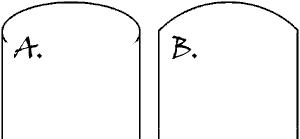Chimney Piece
![]()
Saturday, 19th March 2005, page 2 of 3
Wild West Yorkshire nature diary
Chimney Piece
|
|
Or are they really not seeing things in perspective? I decide to put them to the test by getting everybody to draw the same chimney and dormer window from the same angle, down on the precinct. This time I insist that they should draw it in perspective, exactly as they see it. No free expression. No architectural analysis. Just as it is, seen from our particular viewpoint A Fresh Angle
|
 |
 |
 |
|
One trick I've heard of (David Gentleman once mentioned it on a television demonstration he gave) is to continue the curve of the top of the chimney slightly around the back. |
This is in contrast to drawing an arc and adding two descending lines, which gives a flat, cut-out effect. |
Perhaps you can see it better if I draw a close-up of the angle: in (1.) the angle between curve and vertical is too abrupt but in (2), where I've taken the curve around just a little, you get a better impression of a cylindrical object. |
 My
wobbly pen line smooths out the effect so, just to make it clear, here's
a diagram drawn on the computer.
My
wobbly pen line smooths out the effect so, just to make it clear, here's
a diagram drawn on the computer.
A. The curve of the top of the chimney is taken around the back slightly, giving an impression of a three-dimensional object.
B. The curve abuts abruptly with the verticals so this looks more like a cut-out two-dimensional object, such as the end of a palette knife.
But I'd be wary of adopting this trick: it could so easily become a mannerism.
The important thing is to be aware that you're drawing part of an ellipse
which disappears out of sight: you're not drawing an arc or fan-shape,
snipped off abruptly at either end. ![]()
Richard Bell, richard@willowisland.co.uk